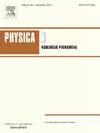端点非均质耦合振荡器链中的相位同步
IF 2.7
3区 数学
Q1 MATHEMATICS, APPLIED
引用次数: 0
摘要
异质网络中集体动态的出现是许多生物网络的一个关键特征。例如,兴奋性的异质性已成为研究胰岛如何协调胰岛素分泌的焦点。这就提出了一个问题,即高度可兴奋的节点如何通过网络协调集体动态,其中很大一部分人口本质上是静止的。为了研究这一点,我们考虑了一个离散版本的复金兹堡-朗道方程,参数化使得在没有耦合的情况下,端点表现出全局吸引极限环行为,内部节点表现出全局吸引平凡不动点动力学。通过模型仿真和数值延拓,研究了模型参数与系统锁相解稳定性之间的关系,重点研究了两种关键解类型,即外节点相位差分别为0和π的v型和反相v型解。我们发现,当内部节点的兴奋性降低时,或者当来自自然极限环的非零耦合引起的振幅扰动的剪切效应增加时,反相v型解稳定。此外,我们发现具有不同相位同步特性的解的双稳性的多个区域,强调在这种网络中观察到的解可能敏感地依赖于初始条件。总的来说,我们的工作强调,具有分布式异构性的链表现出大量的相位同步解决方案,这可能与一系列现实世界的网络相关。本文章由计算机程序翻译,如有差异,请以英文原文为准。
Phase synchronisation in coupled oscillator chains with endpoint heterogeneity
The emergence of collective dynamics within heterogeneous networks is a key feature of many biological networks. Heterogeneity of excitability, for example, has become a focus in the study of how pancreatic islets coordinate insulin secretion. This has raised the question of how highly excitable nodes might coordinate collective dynamics through networks where a large percentage of the population is intrinsically quiescent. To study this, we consider a discrete version of the Complex Ginzburg–Landau equation, parameterised such that in the absence of coupling, the endpoints exhibit globally attracting limit cycle behaviour and the interior nodes exhibit globally attracting trivial fixed point dynamics. Through model simulation and numerical continuation, we interrogate the relationship between model parameters and the stability of several phase-locked solutions of the system, focussing on two key solution types, the chevron and anti-phase chevron solutions, in which the exterior nodes exhibit a phase difference of 0 and , respectively. We find that the anti-phase chevron solution stabilises as the excitability of the interior nodes decreases, or as the shearing effect of non-zero, coupling-induced amplitude perturbations from the natural limit cycle increases. Moreover, we find multiple regions of bistability with solutions with different phase synchronisation properties, highlighting that solutions observed in such networks may depend sensitively on initial conditions. Overall, our work highlights that chains with distributed heterogeneity exhibit a multitude of phase synchronised solutions, which are likely to be relevant in a range of real world networks.
求助全文
通过发布文献求助,成功后即可免费获取论文全文。
去求助
来源期刊

Physica D: Nonlinear Phenomena
物理-物理:数学物理
CiteScore
7.30
自引率
7.50%
发文量
213
审稿时长
65 days
期刊介绍:
Physica D (Nonlinear Phenomena) publishes research and review articles reporting on experimental and theoretical works, techniques and ideas that advance the understanding of nonlinear phenomena. Topics encompass wave motion in physical, chemical and biological systems; physical or biological phenomena governed by nonlinear field equations, including hydrodynamics and turbulence; pattern formation and cooperative phenomena; instability, bifurcations, chaos, and space-time disorder; integrable/Hamiltonian systems; asymptotic analysis and, more generally, mathematical methods for nonlinear systems.
 求助内容:
求助内容: 应助结果提醒方式:
应助结果提醒方式:


